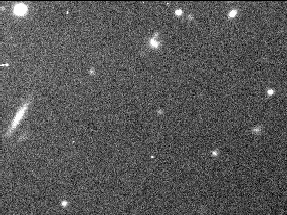Tarvos /ˈtɑːrvɒs/, or Saturn XXI, is a prograde irregular satellite of Saturn. It was discovered by John J. Kavelaars et al. on September 23, 2000, and given the temporary designation S/2000 S 4. The name, given in August 2003, is after Tarvos, a deity depicted as a bull god carrying three cranes alongside its back from Gaulish mythology.[8]
 Animation of discovery images taken by the CFHT in September 2000 | |
| Discovery[1] | |
|---|---|
| Discovered by | B. J. Gladman et al.[2] |
| Discovery date | September 23, 2000 |
| Designations | |
Designation | Saturn XXI |
| Pronunciation | /ˈtɑːrvɒs/ |
Named after | Tarvos Trigaranus |
| S/2000 S 4 | |
| Adjectives | Tarvian[3] |
| Orbital characteristics[4] | |
| Epoch 2000 January 1.5 | |
| 18.215 Gm | |
| Eccentricity | 0.528 |
| 926.4 d (2.54 yr) | |
| Inclination | 38.6° |
| Satellite of | Saturn |
| Group | Gallic group |
| Physical characteristics | |
Mean diameter | 15+50% −30% km[5] |
| Albedo | 0.06 assumed[5] |
Spectral type | light red B−V=0.77, R−V=0.57[6] |
| 22.1[7] | |
| 12.9[7] | |
Orbit

Tarvos orbits Saturn at an average distance of 18 million km in 926 days and is about 15 km in diameter (assuming an albedo of 0.06).[5] It has a high orbital eccentricity of 0.53.[4]
It is a member of the Gallic group of irregular satellites.
Origin
With a similar orbit and displaying a similar light-red colour, Tarvos is thought to have its origin in the break-up of a common progenitor[6][9] or to be a fragment of Albiorix.[10]
References
External links
- Ephemeris IAU-MPC NSES
- Saturn's Known Satellites (by Scott S. Sheppard)